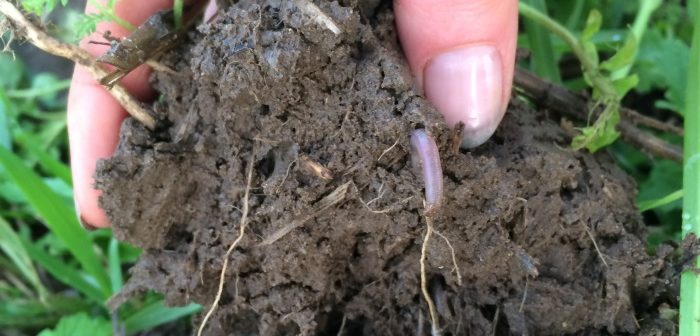A nationwide study of commercial wheat crops in arable soils has revealed a huge variation in the levels of soil-borne beneficial fungi. The results indicate that soil management practice directly influences how much a wheat crop can benefit from arbuscular mycorrhizal fungi (AMF).
Variety choice can also have a sizeable influence on colonisation of wheat roots by AMF, which is believed to have the effect of substantially increasing the ability of plants to access water and nutrients from the soil. Use of cover crops treble AMF colonisation, according to results.
The study, carried out by the British On-Farm Innovation Network (BOFIN) and Crop Science Centre, looked at colonisation of wheat roots by AMF from over 40 samples sent in by the Soil Squad – farmer members of the network. All followed the same protocol to dig up and process the root sample from first wheat crops, most of which were the varieties KWS Extase or Skyfall.
The results varied from around 5% of roots colonised to almost 69%. The frequency of arbuscles was found to vary from around 34% to none at all. These highly branched fungal structures inside the plant root provide an enormous surface area over which the fungi can trade mineral nutrients (mostly phosphorus and nitrogen) for plant carbon, in the form of lipids and sugars.
All growers who took part submitted details of cultivation practice, soil type and farming system. Direct drilling brings the most root colonisation at 36%, followed by shallow non-inversion tillage at 32%, while the lowest proportion of AMF was found in deep tillage systems (27%).
The highest levels of AMF were found in organic systems at 50% of roots colonised, although only three organic samples were submitted. Most of the Soil Squad farmers claimed to be regenerative and these samples had significantly more AMF at 37% than those submitted by conventional arable farmers at 26%.
Colonisation tended to be highest in medium soils (36%), followed by heavier soil types (33%) with lowest levels found in light soils (25%).
“The results on tillage practices are really interesting and pretty clear – less disturbance is better for these fungi,” notes Dr Tom Thirkell of CSC, who led the project and carried out the analysis.
“Comparing between conventional, regenerative and organic farming systems shows a similar story, although more complex. But the trend there is really stark too,” he adds.
“What really surprised us, though, was the range we’ve found in the farmers’ samples. We didn’t expect to see any above 30-40%, so to have some over 60% is quite exciting.”
The study was supported by plant breeders RAGT Seeds and KWS UK, who also provided samples from small-plot trials near Cambridge. “At RAGT they are looking at the effect of a range of cover crops on Skyfall,” reports Tom.
“The results indicate you get almost three times as much AMF colonisation if you put Skyfall into land after a cover crop than if it follows fallow.”
A range of KWS varieties, all grown in the same field with the same management practice were compared. “The colonisation varied from about 20% to almost 50%, just depending on the cultivar,” notes Tom.
“Extase was the highest at 48.1%, while perhaps Palladium doesn’t think it needs mycorrhizas in quite the same way. The nature of the relationship is that the wheat plant decides when and to what extent it trades resources.”
The study is believed to be the first nationwide survey of levels of AMF in commercial wheat crops. Samples were received from Dundee to Somerset, Essex to the Welsh borders. “We had a terrific response from members to this project,” notes BOFIN managing director and founder Tom Allen-Stevens.
“We sent out 77 packs with detailed instructions and a special sampling kit to ensure roots were returned in good condition. Every single sample returned had been taken correctly with full details supplied, ensuring we had a really good dataset,” he notes.
“The survey data we’ve gathered from these farmers’ samples really emphasise the importance of soil types and management for mycorrhizas in agriculture,” continues Tom, who has visited many of the farmers who took part in the survey and discussed at length their farming practice.
“There are few surprises in the results – those who take the best care of their soils really do have the highest levels of this important fungi.”
One of the oldest symbiotic relationships in nature (going back 460M years) is the one plants have with AMF. It’s also currently thought to be the origin of the relationship legumes use to fix nitrogen from the air.
Plants feed carbon to the fungi in exchange for nutrients delivered from the soil. This fungal carbon is very long-lived suggesting AMF may also provide an effective way to sequester carbon in arable soils.
Work at CSC is exploring the signalling pathways – the ability of plants to control this trade of resources. Cultivars of spring barley grown in plots near Cambridge have had genes edited to knock out the ability to make the association with AMF, while there are also GM cultivars where this relationship is overexpressed.
BOFIN is leading a major new farmer-led three-year research project, due to start in January, that will explore in much greater detail the relationship wheat roots have with the microbial communities in the soil.




